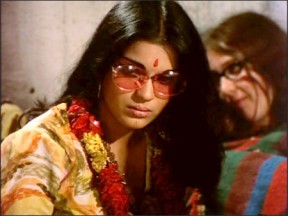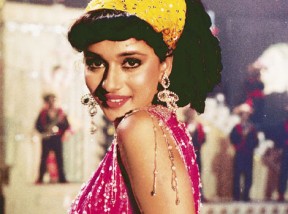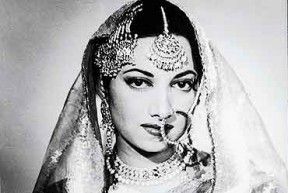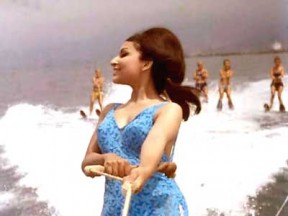Every film loving generation in India has had a definitive Hindi film heroine. Suraiya was possibly India’s first female superstar and was a perfect fit for the cinema of 40s and the 50s that was rich with Urdu poetry and elemental stories of passion and sacrifice. She was the reigning queen of the developing Talkie era and her voice, untrained yet sweetly resonant and her beauty made her the face of the mostly melancholy, always poetic and occasionally playful heroine.
**
Every memorable face in cinema has connected with the age it belonged to. The rich tradition of Muslim social films required an old world dignity, heart-stopping beauty, the ability to deliver dialogues in poetic Urdu and some amount of dancing skill. Madhubala in Mughal-E-Azam, Meena Kumari in Pakeezah, Wahida Rehman in Chaudhvin Ka Chand personified a sumptuous, decorous culture, music,and poetry. They along with Nargis (who occasionally strayed out of the box), played other characters with aplomb but they were faces of tradition, of femininity and idealised womanhood.
**
In the 60s, India began to look Westwards and the narratives were playful like Hollywood musicals and we had stars like Saadhana, Sharmila Tagore, Saira Banu and Asha Parekh among others who could be traditional and carry off superficially modern, flighty city girls as well. These were girls who romanced their heroes in London, Paris, Tokyo and also in the valleys of Kashmir. Saira Banu could pull off both a Kashmir Ki Kali in Junglee and a blond, leggy, mini skirted anglicised girl with a cigarette in Purab Aur Paschim. Sharmila Tagore could be a Satyajit Ray heroine and a swimsuit clad tourist in an Evening In Paris.

Asha Parekh, a trained classical dancer also danced memorably to a Rock n Roll number in Teesri Manzil.The 70s saw the Western influence becoming more and more pronounced and along with a quintessential Indian dream girl like Hema Malini, we had heroines like Zeenat Aman and Parveen Babi who could have pulled off a Bond girl with prefect ease if they had been asked to play one. Zeenat Aman’s most memorable role is as the flower-child Janice (in Hare Rama Hare Krishna) who hung around with hippies in Nepal and till date remains one of the most individualistic female characters in Indian cinema.The 80s brought many faces but two leading ladies brought with them a distinct identity that could stand up to any hero and carry off big budget films alone.

They were Sridevi and Madhuri Dixit. Their box-office clout was no less than any hero and they represented the fact that women could define their own roles in society and fight their own battles. They were strong women who also did not completely reject tradition. In Mr India, Sridevi plays a reporter but is also a soft-hearted nurturer of the many orphans she shares a home with. In Chaalbaaz, she is both a beer guzzling rebel and a shy, self-effacing damsel in distress. Madhuri Dixit was the hero of Beta and Raja, two films supposedly named after the male protagonists and was an equal of the hero in every respect in the cult hit, Hum Aapke Hain Kaun. Aishwarya Rai too defined stardom on her own terms and was and still is one of the most recognisable faces of Indian cinema in the global industry.

In the last 10 years though, Indian films have moved more and more away from India to address the diaspora and the Indian outside India and one of the most successful faces of this era is Katrina Kaif. Unlike Kareena Kapoor who is inspired by mainstream Bollywood icons like Sridevi, Madhuri Dixit and her own sister Karisma Kapoor, Katrina has no reference points, possibly no awareness of Hindi cinema’s history, very little understanding of its legacy, its landmark moments but the fact that Yash Chopra, the most coveted film director by generations of heroines chose her to star in his last film says something. She is not a typical Hindi film heroine and perhaps that is what has worked in her favour. Her anglicised Hindi strikes a chord with the generation that largely converses in English.
**
She inspired a Barbie Doll too and that should tell us something too. She is emblematic of a generation that does not define its identity by Geography and instead travels everywhere and where ever work and leisure calls them. She belongs to New York, London, to India, Pakistan and India, and was voted some time back as one of the most desirable women in the world. She represents the future of Hindi cinema where a Hindi film heroine will not just be required to dance in set pieces but to also play a spy, a scuba instructor, a global citizen. She will not probably have the substance and gravitas of the greatest Hindi film heroines but she will have aspirational glamour that does not belong to one milieu but to many.
This story was earlier published in The New Indian Express











